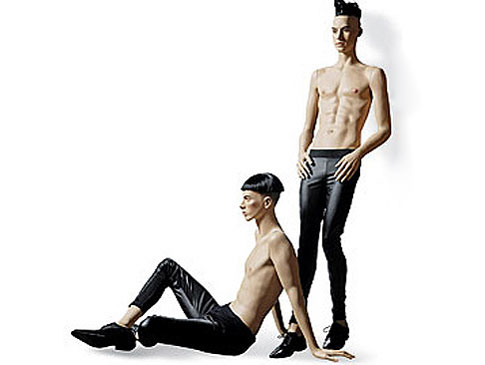Manorexia On the Rise With Skinny Jeans
Much attention has been focused on metrosexual men and their manscaping ways in recent years, but a renewed interest in male grooming and body image comes with the introduction of an impossibly skinny, 27-inch waist male mannequin, dubbed “Homme Nouveau,†by British manufacturer Rootstein to make its debut next month. {New York Daily News}

The new 27" waist "Homme Nouveau" mannequins
This new size mannequin, which comes complete with a 35-in chest and not an ounce of discernible fat, along with metrosexuality could be causing some men to hold themselves to the kind of unrealistic body ideals women are subject to, and some men may be attempting to wither down to proportions capable of looking as good in trendy, super-tight clothing as the “Homme Nouveau†does.
Rootstein describes its new mannequin as, “the young and restless redresses the balance of the prevailing male beefcake figure by carving out a far more streamlined sinuous silhouette to match the edgier attitude of a new generation.†{NPR}
If by “edgier attitude†they mean tendency to develop eating disorders, statistics are beginning to show they may be right.

A look from Dior Homme during Hedi Slimanes tenure, where extra slim silhouettes were favored
GQ Style Editor Adam Rapaport says it is naïve to think men are all of a sudden more concerned with their appearance based on the “Saturday Night Fever,†hair sculpting, skinny pant-wearing days of the past (or Hedi Slimane’s slim Dior Homme silhouettes more recently), but evidence shows anorexia in men (read: manorexia) is on the rise, leading to the question of whether the skinny jeans for men trend may be at the root of it.
Today, 25 percent of eating disorder sufferers are men, up from 10 percent in 1990, and 40 percent of binge eaters are men. {New York Magazine}
Some experts cite the renewed pressure men are under to fit into slim clothes. American Apparel has a line of denim pants with a maximum waist size at 33 inches, though the average waist size for an American man in 2006 was 39.7 inches. In addition Rootstein’s mannequins have gradually shrunk in waist size over the years, beginning at 33 inches in 1967, down to 31 inches in 1983 and 28 inches in 1994.{New York Magazine}
“The body is on display more in men’s clothing today,†Radford University psychologist Dr. Tracy Cohn says. “The cuts aren’t as blousy and there is not as much fabric. Clothes cling to the body. The cuts are called close-fit or tailor-cut. And they taper into the body.â€
Rapaport says it is not just jeans but everything in menswear that is skinnier these days including slim suits and skinny ties.
“Now it’s all skinny skinny skinny, whether you are or not,†he says, adding that the new generation is not smaller, they are just wearing clothes that are, moving away from the baggy, below-the-butt sagging pants that New York politicians abhor.
“Typically in fashion the pendulum swings,†Rapaport says. “If everyone’s wearing big baggy jeans, then the cool kids want to be wearing skinny tight jeans. Once everyone does something, the elite want to do the opposite.â€
If you are a man uninterested in whittling down to 14-year-old boy proportions to fit into these clothes, Rapaport sees no need to be concerned. He admits most women probably do not like to see a man in something that super skinny. He also advises men to look at this trend as an extreme by which to be inspired – rather than which to aspire to – to wear clothes that simply fit better and are more tailored than what we are used to seeing men wear.
It’s interesting that this trend emerges just as attention is finally being focused on the inclusion of curvier women in modeling and a movement away from the scrawny female runway look. That being said, we definitely agree with Rapaport. Women do not necessarily want to see super skinny men in super tight clothing, but clothes that fit well are a huge step up from baggy, sagging looks that do nothing to flatter a man’s body.
